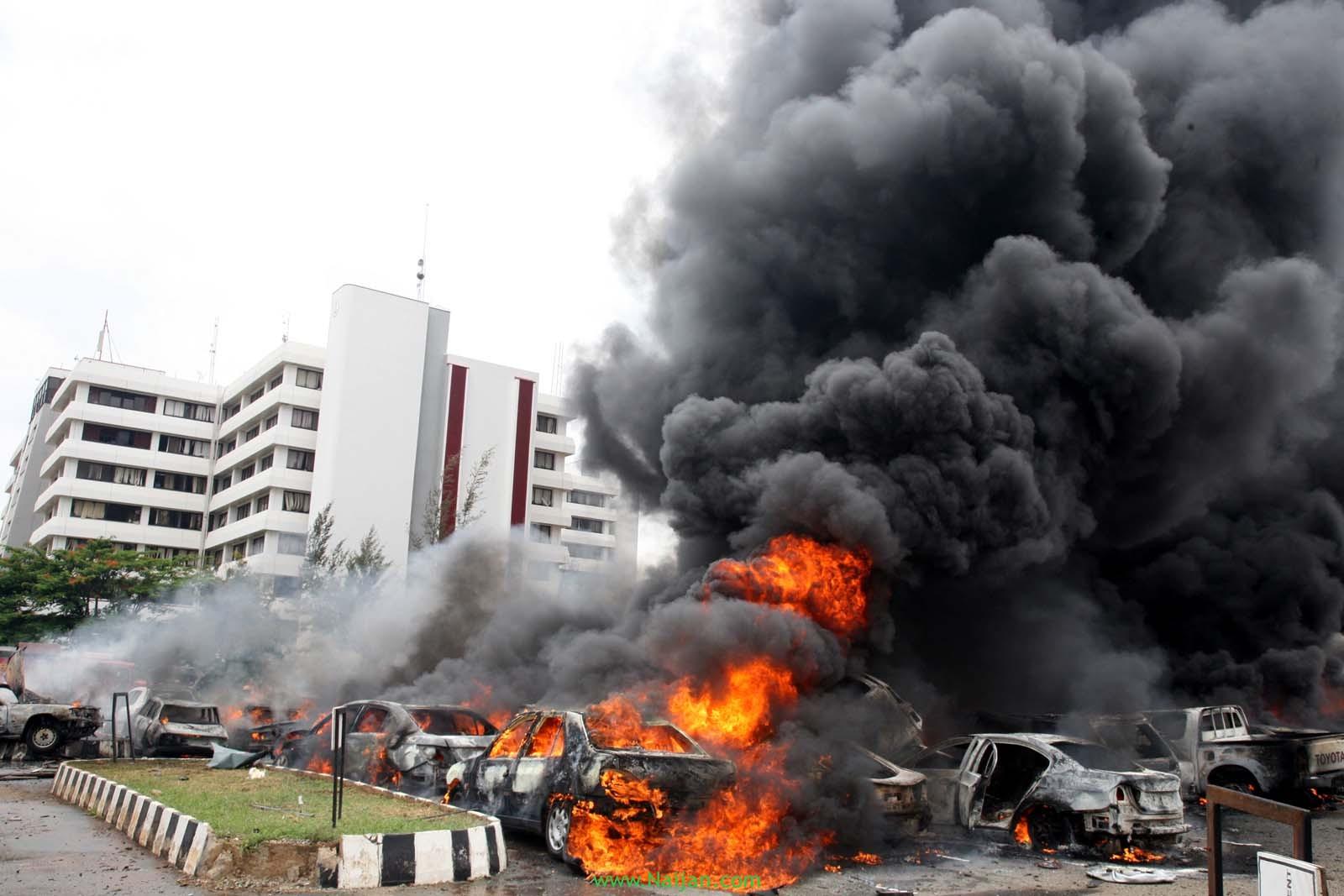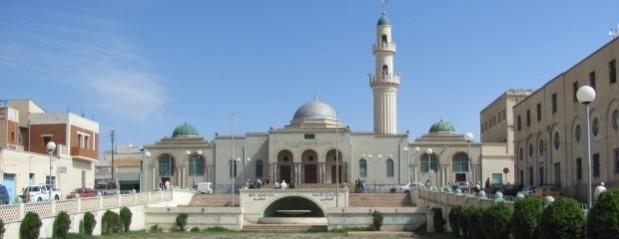Where will Boko Haram go next after ten years of moving around?

In the past decade, Boko Haram has gone from a village in Yobe, to attacking major cities, to bedding in around Lake Chad.

The August 2011 Boko Haram bombing outside the UN building in Nigeria’s capital Abuja killed at least 21 people. Credit: Gbemiga Olamikan.
Ten years ago in July 2009, Nigeria’s security forces cracked down on what was then a relatively little-known Islamic group in the north east of the country. At the time, that group’s focus was preaching, although it believed al-Qaeda’s path would bring Nigerian Muslims out of their abyss. The military operation led to the deaths of hundreds of its members, including the group’s leader and cleric Muhammed Yusuf.
Following this deadly attack, few expected Boko Haram to rebuild. Even fewer could have predicted that a decade later, the group would have the capability to raid military barracks not just in Nigeria but across the Lake Chad region. In the past year alone, the Islamist militants have attacked bases in Baga, Nigeria, Darak, Cameroon, and Dangdalla, Chad, while attacks in Niger continue to escalate. In the ten years since the insurgency began, the death toll from the conflict is at least 30,000 people, though observers suggest the real total could be closer to 70,000.
Today, a decade since it was almost wiped out, Boko Haram has an estimated 6,000 fighters broken into two factions. The larger and more sophisticated group is affiliated with so-called Islamic State and known as Islamic State in West Africa Province (ISWAP). The smaller and cruder faction is led by the notorious Abubakar Shekau and is called Jama’at Ahl al-Sunnah li-l-Dawah wa-l-Jihad (JAS).
ISWAP and JAS combined control less territory now than in 2014 when Shekau declared an “Islamic state” in Nigeria. The factions also have less capacity to launch attacks across a wide area than in 2012 when the militants regularly targeted central and northern cities in Nigeria, including the capital Abuja and the northern commercial hub Kano.
But looks can be deceiving. ISWAP’s territorial control around Lake Chad is more consolidated and its attacks fiercer than ever before. The same can be said of JAS in Borno state’s Sambisa Forest.
As the following explains, the insurgency’s ten-year evolution and geographical movements tell us a lot about the group’s history and what could happen next.
Spreading out from a Yobe village: 2002-2009
In the early days of 2002-3, the group then called the “Nigerian Taliban” was made up of around 200 predominantly wealth and well-educated individuals with a small base in a village in Yobe State. There are still debates on whether group members intended to pursue a jihad in Nigeria but were too under-resourced or whether they were generally non-violent but sought to engage in hijra (migration to flee persecution) from the “impure” cities where “full sharia” was not practiced.
The group’s main leader at the time, Muhammed Ali, was involved with al-Qaeda in Sudan, if not elsewhere, in the 1990s and recruited at universities. Other members were recruited from north-eastern Nigerian mosques, including the one where Yusuf preached in Maiduguri. Hence, Ali and Yusuf are often considered to be the group’s first co-leaders.
Because of the group’s austere Taliban-like interpretation of Islam and its killing of a security officer who came to inspect their camp, the government eventually took action. In December 2003, security forces destroyed the group’s encampment and killed around twenty group members including Ali.
In the following years, the group rebounded under the sole leadership of Yusuf. He shifted the group’s locus to Maiduguri, the capital of Borno state, while also establishing centres in Sokoto, Kano, and Bauchi states in Nigeria and Diffa region in Niger. In these areas, Yusuf and his deputies, including Shekau, preached their ideology calling for an Islamic state in Nigeria and opposing Western influences. The name “Boko Haram”, meaning “Western education is blasphemous”, emerged as a nickname used by outsiders to mock Yusuf’s prohibitions on Western schools.
In July 2009, security forces once again attacked the group, seeing Yusuf’s growing influence as a political threat. Members claim that the military killed around 200 of its members in the crackdown, including Yusuf.
Maiduguri and other major cities: 2009-2012
The government thought Yusuf’s followers would never re-emerge after the crackdown, but under the leadership of Shekau, the group hit back. It conducted deadly attacks and by 2011, its area of operations had expanded to cover virtually everywhere Yusuf’s preaching had reached. Most assaults, however, were still in Maiduguri where Shekau established a hideout. They tended to be assassinations, arsons, and small-scale bombings of government buildings.
From mid-2011, suicide bombings became commonplace with more than 30 reported by the end of 2012. These attacks and other bombings tended to be conducted further afield in cities such as Kaduna, Jos, Abuja and Kano as well as elsewhere in central Nigeria.
This difference in attacks between Maiduguri and central regions can be explained by the fact that dozens of members trained with Al-Qaeda in the Islamic Maghreb (AQIM). These fighters tended to oppose Shekau’s attacks on Muslims and instead targeted mostly Christians, media houses, and military barracks away from Shekau’s main bases in Maiduguri.
Retreating to a rural force: 2013-2016
In 2013, Nigerian security forces managed to dismantle some of Boko Haram’s lethal cells that specialised in bomb-making in central Nigeria.
One factor that aided this was that some AQIM-trained fighters left to form a splinter group known as Ansaru. Shekau responded by ordering loyalists to attack the new faction, beheading and assassinating its leaders and reportedly even tipping off security forces with information about Ansaru members’ hideouts. This helped the military break up Ansaru’s kidnapping cells in Kaduna, Sokoto, and Kano. At the same time, any sympathy Shekau’s fighters had from locals withered after he ordered attacks causing hundreds of civilian casualties starting in January 2012.
From 2013 therefore, the group became more deep-seated in rural Borno. It reintegrated some Ansaru members, reportedly through a reconciliation brokered in Mali, and conquered parts of the state. This led to more attacks including the April 2014 kidnapping of more than 200 schoolgirls in Chibok. The group removed its fighters from Maiduguri, where it faced pressure from pro-government civilian vigilantes, and became almost completely rural-based.
In March 2015, Shekau pledged allegiance to Islamic State leader Abubakar al-Baghdadi and the group became ISWAP. Although Nigeria, its neighbours and South African contractors had already pushed the group out of most of its territories by this point, the new pledge may have further incentivised them to destroy the group.
In late-2015, however, ISWAP employed some effective strategies to reassert itself. It launched numerous attacks, especially female suicide bombings, in order to dissuade Nigeria’s neighbours from intervening. In June 2016, it then raided Bosso military barracks to pilfer weapons. Also significant in August 2016 was that Islamic State demoted Shekau and named Abu Musab al-Barnawi as ISWAP’s new leader. Al-Barnawi instituted a “hearts and minds” approach to the civilian population and concentrated on denying the Nigerian army access to rural areas in Yobe, Borno and around Lake Chad. Shekau left ISWAP and reinforced his main base in Sambisa Forest, Borno. His faction returned to its official name JAS.
ISWAP and JAS were now rivals, but have generally avoided clashing since August 2016. ISWAP has become a far superior force as seen in its increased barracks raids and professional Islamic State-integrated media apparatus. There also are reports of Islamic State sending delegations to Nigeria from Libya to train fighters and of ISWAP establishing taxation systems for basic commodities to raise money from local civilians. JAS, in contrast, remains fairly crude but still dangerous.
Where next?
ISWAP’s successes since August 2016 have garnered significant attention among scholars, humanitarian organisations and governments. However, what is often forgotten with the focus on current battles near Lake Chad and in rural Borno is how the group was historically pervasive throughout northern Nigeria. In the past few years, the military has also scored victories against ISWAP and has contained JAS primarily in Sambisa. But if ISWAP is finally pushed out of its current bases near Lake Chad, the question remains whether this will be enough to end the insurgency.
The answer likely depends on whether ISWAP maintains the capability to operate elsewhere. Looking back over the past decade reminds us that neither ISWAP nor JAS has any grounding in its once main base of Maiduguri. At best they can only attack its periphery. It has also been nearly four years since the last assault anywhere outside of Nigeria’s three north-eastern states. This suggests that once the jihadists are kicked out of an area, a combination of military force and resilient civilians can keep them out for good. If this trend continues, then if ISWAP is kicked out of Lake Chad, it may not return.
At the same time, however, ISWAP has also proven its ability to establish strongholds in new areas. This makes the group’s current expansion in Niger particularly concerning. There are also reports of ISWAP and remnants of Ansaru attempting to establish new hideouts in forests of north-western Nigeria near Kaduna.
Finally, it should also be recalled that in the Islamic State organisational structure, ISWAP is now merged with Islamic State in Greater Sahara (ISGS), which operates in the Niger-Burkina Faso-Mali border axis and whose possible penetration of north-western Nigeria is cause for great concern in of itself. While there have not been significant exchanges between the two groups, the alliance indicates they would offer each other support in a worst case scenario.
Since the Boko Haram insurgency began ten years ago, the group has moved around geographically as it has evolved and split. A decade in, it remains a potent and dangerous force likely to continue changing and moving for some time to come.






Good Update. Keep it up. Well done.